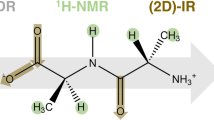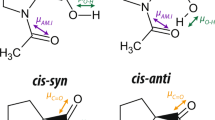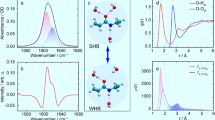Abstract
SHORT alanine peptides, containing 16 or 17 residues, appear to form α-helices in aqueous solution1–4. But the main spectroscopic analyses used on helical peptides (circular dichroism5 and nuclear magnetic resonance6–8) cannot distinguish between an α-helix (in which the ith residue is hydrogen-bonded to residue i+4; ref. 9) and the next most common peptide helix, the 310-helix10 (i → i + 3 hydrogen-bonding). To address this problem we have designed single and doubly spin-labelled analogues of alanine-based peptides in which the nitroxide spin label forms an unbranched side chain extending from the sulphur atom of a cysteine residue. Here we report the circular dichroism, Fourier-transform infrared and electron-spin resonance spectra of these peptides under helix-forming conditions. The infrared absorbance gives an amide I' band with a frequency that is substantially different from that observed for α-helices. The electron-spin resonance spectra of doubly labelled helices show that the ranking of distances between side chains, around a single turn (residues 4–8), is inconsistent with an α-helical structure. Our experiments suggest that the more likely peptide geometry is a 310-helix.
This is a preview of subscription content, access via your institution
Access options
Subscribe to this journal
Receive 51 print issues and online access
$199.00 per year
only $3.90 per issue
Buy this article
- Purchase on Springer Link
- Instant access to full article PDF
Prices may be subject to local taxes which are calculated during checkout
Similar content being viewed by others
References
Marqusee, S., Robbins, V. H. & Baldwin, R. L. Proc. natn. Acad. Sci. U.S.A. 86, 5286–5290 (1989).
Merutka, G., Lipton, W., Shalongo, W., Park, S. H. & Stellwagen, E. Biochemistry 29, 7511–7515 (1990).
Chakrabartty, A., Schellman, J. A. & Baldwin, R. L. Nature 351, 586–588 (1991).
Padmanabhan, S., Marqusee, S., Ridgeway, T., Laue, T. M. & Baldwin, R. L. Nature 344, 268–270 (1990).
Manning, M. C. & Woody, R. W. Biopolymers 31, 569–586 (1991).
Osterhout, J. J. et al. Biochemistry 28, 7059–7064 (1989).
Bradley, E. K., Thomason, J. F., Cohen, F. E., Kosen, P. A. & Kuntz, I. D. J. molec. Biol. 215, 607–622 (1990).
Würthrich, K. NMR of Proteins and Nucleic Acids (Wiley, New York, 1986).
Voet, D. & Voet, J. G. Biochemistry (Wiley, New York, 1990).
Barlow, D. J. & Thornton, J. M. J. molec. Biol. 201, 601–619 (1988).
Todd, A. P. & Millhauser, G. L. Biochemistry 30, 5515–5523 (1991).
Miick, S. M., Rodd, A. P. & Millhauser, G. L. Biochemistry 30, 9498–9503 (1991).
Byler, D. M. & Susi, H. Biopolymers 25, 469–487 (1986).
Kennedy, D. F., Crisma, M., Toniolo, C. & Chapman, D. Biochemistry 30, 6541–6548 (1991).
Malcolm, B. R. Biopolymers 22, 319–321 (1983).
Dwivedi, A. M., Krimm, S. & Malcolm, B. R. Biopolymers 23, 2025–2065 (1984).
Prestrelski, S. J., Byler, D. M. & Thompson, M. P. Int. J. Peptide Protein Res. 37, 508–512 (1991).
Luckhurst, G. R. in Spin labeling: Theory and Applications (ed. Berliner, L. J.) Ch. 4 (Academic, New York, 1976).
Falle, H. R. et al. Molec. Phys. 11, 49–56 (1966).
Lemaire, H., Rassat, A., Rey, P. & Luckhurst, G. R. Molec. Phys. 14, 441–447 (1968).
Krystek, S. R. et al. FEBS Lett. 299, 255–261 (1992).
Toniolo, C. & Benedetti, E. Trends. biochem. Sci. 16, 350–353 (1991).
Karle, I. L. & Balaram, P. Biochemistry 29, 6747–6756 (1990).
Gautam, B., Bagchi, K. & Kuki, A. Biopolymers 31, 1763–1774 (1991).
Tirado-Rives, J. & Jorgensen, W. L. Biochemistry 30, 3864–3871 (1991).
Author information
Authors and Affiliations
Rights and permissions
About this article
Cite this article
Miick, S., Martinez, G., Fiori, W. et al. Short alanine-based peptides may form 310-helices and not α-helices in aqueous solution. Nature 359, 653–655 (1992). https://doi.org/10.1038/359653a0
Received:
Accepted:
Issue Date:
DOI: https://doi.org/10.1038/359653a0
This article is cited by
-
Constructing a structural model of troponin using site-directed spin labeling: EPR and PRE-NMR
Biophysical Reviews (2019)
-
Thermodynamics of helix formation in small peptides of varying length in vacuo, in implicit solvent, and in explicit solvent
Journal of Molecular Modeling (2019)
-
Peptide Folding Problem: A Molecular Dynamics Study on Polyalanines Using Different Force Fields
International Journal of Peptide Research and Therapeutics (2013)
-
The spin label amino acid TOAC and its uses in studies of peptides: chemical, physicochemical, spectroscopic, and conformational aspects
Biophysical Reviews (2012)
-
Helix and H-bond formations of alanine-based peptides containing basic amino acids
Structural Chemistry (2011)
Comments
By submitting a comment you agree to abide by our Terms and Community Guidelines. If you find something abusive or that does not comply with our terms or guidelines please flag it as inappropriate.



